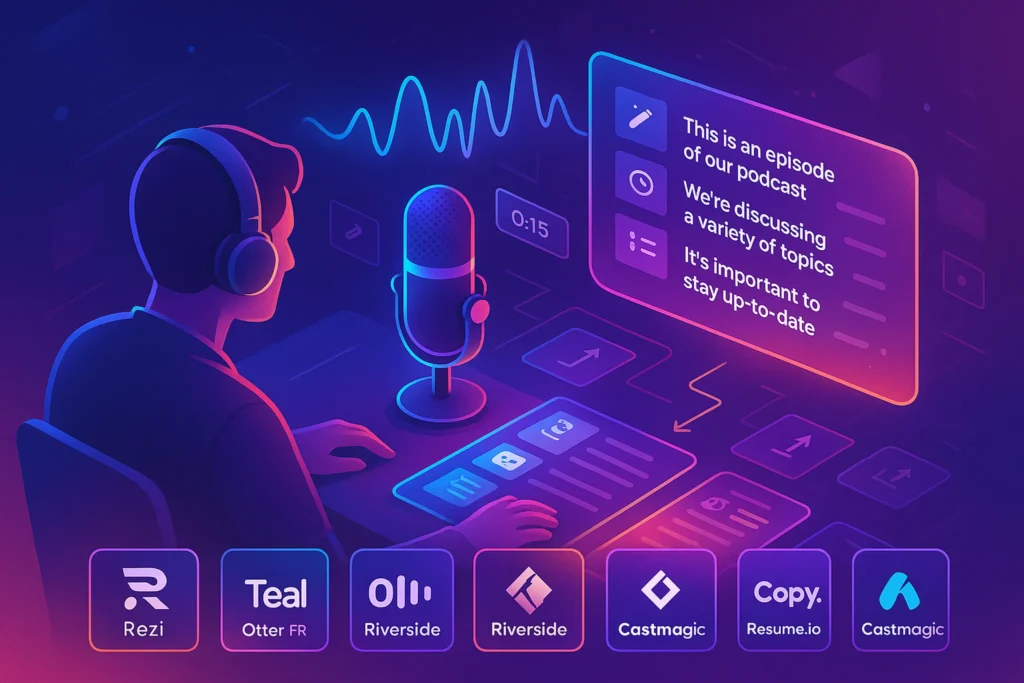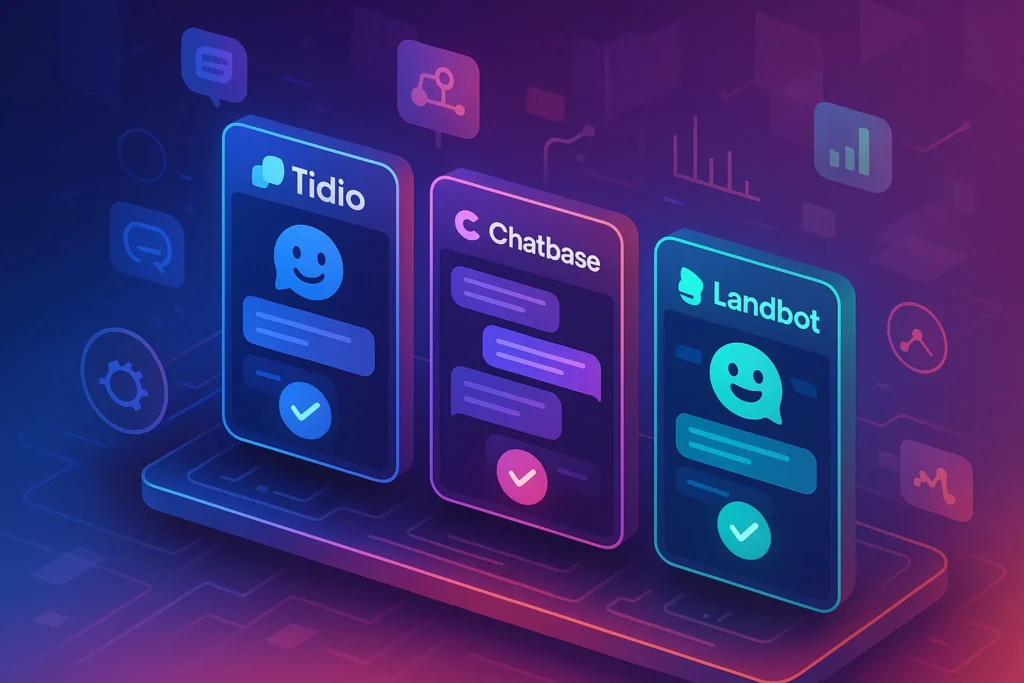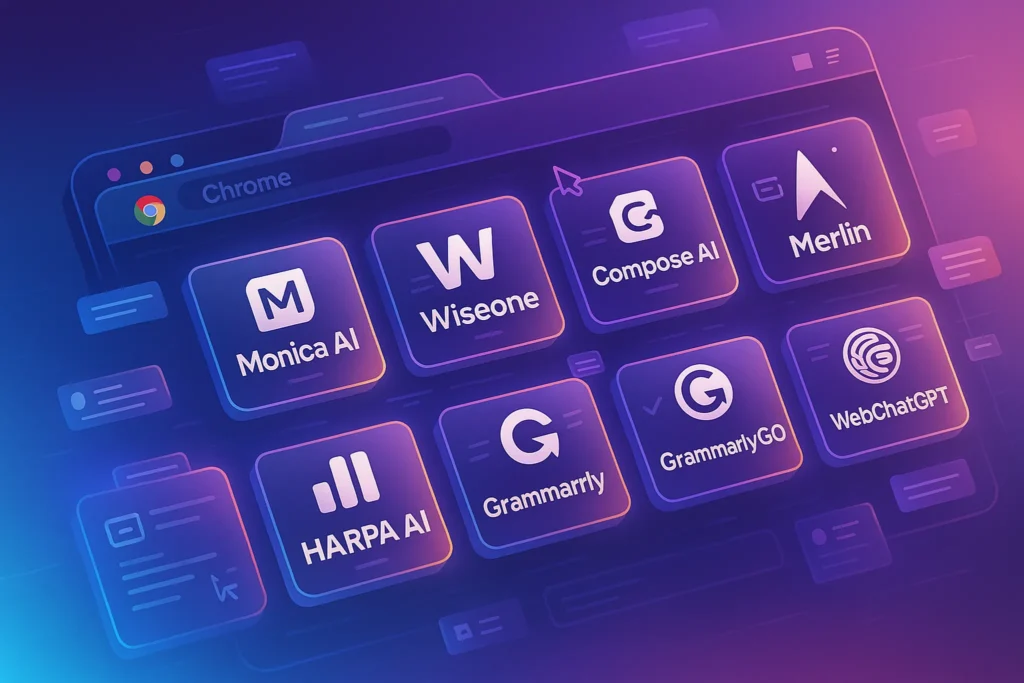-This post may contain affiliate links. If you click on one and make a purchase, I may earn a small commission at no extra cost to you.-
🚀 Introduction – Transcripts: The Hidden Power of Podcasts
Publishing a podcast means more than just recording and uploading. To gain SEO traction, repurpose your content wisely, and reach broader audiences, you need accurate, editable transcripts. But manual transcription is expensive and time-consuming. That’s why AI transcription tools are essential.
If you’re just starting your podcasting journey and looking for a complete roadmap — from choosing your gear to publishing your first episode — don’t miss our in-depth guide on how to start a successful podcast from scratch. It walks you through everything: planning your format, picking the right mic, recording, editing, hosting, promotion, and even monetization strategies for creators of all levels.
This guide highlights the six best AI transcription tools that deliver:
-
🔍 High accuracy for spoken word and multiple voices
-
⚡ Fast turnaround times—minutes, not hours
-
📚 Content repurposing features (show notes, blog posts, audiograms)
-
💲 Cost-effective pricing models, from pay-as-you-go to subscriptions
By the end, you’ll know which tool fits your workflow—whether you’re a solo indie podcaster or a growing network.
📝 Tool List with Deep Dives
1. Rev – Best Overall Accuracy
Why It Matters: When your podcast is interview-heavy or needs legal or journalistic-grade transcription, accuracy is non-negotiable. Rev offers optional human editing for unmatched quality.
Real Use Case: A legal podcaster uses Rev to transcribe interviews with attorneys for accurate quotes and timestamps. Human verification ensures nothing is lost in translation.
Practical Scenario: Upload your final podcast mix; receive an AI transcript in minutes and a polished human version in a few hours.
Key Features:
-
Pay-as-you-go ($0.25/min)
-
Low-confidence word highlighting
-
Integrated editing tools
Free Plan: No; pay per minute
Verdict: Best for accuracy and professional workflows
2. Descript – Best for Editing + Transcription
Why It Matters: Descript turns transcripts into an audio/video editing platform. For creators who want to edit their show like a doc, it’s a game changer.
Real Use Case: A solo podcast producer edits entire episodes by deleting words in the transcript. Descript auto-updates the audio—no DAW needed.
Practical Scenario: Trim filler words (“uh”, “like”) from transcript, immediately reflected in audio.
Key Features:
-
Text-based editing
-
Auto-transcription + speaker labeling
-
Overdub & studio sound
Free Plan: 1 hr/month free transcription
Verdict: Best for editable audio workflows
3. Otter.ai – Best for Live Recording
Why It Matters: Otter is your live meeting assistant—ideal for panel discussions, planning calls, and remote interviews. You get transcription + summaries instantly.
Real Use Case: A podcaster records virtual interviews using Otter + Zoom. Otter transcribes live, then syncs with calendar notes for quick editing later.
Practical Scenario: Conduct a Zoom interview via Otter; download and edit transcript post-recording.
Key Features:
-
Live transcription
-
Speaker diarization
-
Slide/caption capture
Free Plan: 300 min/month
Verdict: Best for live recording/transcription
4. Trint – Best for Team Collaboration
Why It Matters: If you’re part of a podcast team—host, editor, marketer—Trint provides shared editing, comments, and quick export to CMS tools.
Real Use Case: A podcast team edits an episode together: one edits the transcript, another extracts quotes, and a third repurposes it into an email newsletter—all in one platform.
Practical Scenario: Team edits transcript, tags guests, then sends it straight to CMS.
Key Features:
-
Automatic script segmentation
-
Speaker identification
-
Team-based commenting/editing
Free Plan: No; subscription-based
Verdict: Best for team-driven content workflows
5. Sonix – Best Multilingual & Fast
Why It Matters: Sonix is ideal for international podcasts or creators interviewing guests from different regions. High-speed multilingual accuracy means smoother global content.
Real Use Case: A multilingual health podcast records in English, German, and Spanish. Sonix transcribes all with high precision and auto-translates to English for syndication.
Practical Scenario: Upload a Czech-language episode; Sonix auto-generates both Czech and English transcripts.
Key Features:
-
30+ languages
-
Timestamped transcripts
-
Speaker labeling
-
Fast export options
Free Plan: Trial available
Verdict: Best for international podcasts
6. Happy Scribe – Best Affordable Plan
Why It Matters: Budget-conscious podcasters can scale transcriptions without sacrificing clarity. Great for long-form content where affordability matters.
Real Use Case: A podcast network uses Happy Scribe to transcribe 10+ shows weekly. With pay-as-you-go pricing and bulk uploads, they save money while staying consistent.
Practical Scenario: Transcribe 60-minute episodes for under $20 with auto timestamps and speaker detection.
Key Features:
-
Pay-as-you-go or subscription
-
Clean UI and editing
-
Timestamping, speaker ID
Free Plan: No; pay per minute
Verdict: Best for budget-conscious creators
🎙️ The Power of Podcast Transcripts: Why They Matter in 2025
Industry Snapshot & Data
-
According to a 2024 Edison Research survey, 78% of weekly podcast listeners read show notes and most prefer transcripts alongside audio.
-
Search engine analysis shows that podcasts with full transcripts generate 2–3× more search visibility than audio-only content.
Benefits of Having Podcast Transcripts
-
SEO Optimization – Transcribed episodes contain rich, indexable keywords that help search engines discover and rank your content.
-
Content Repurposing – Transform your script into blog posts, social media threads, audiograms, newsletters, and even videos.
-
Accessibility & Inclusion – Hearing-impaired listeners, non-native speakers, and readers enjoy transcripts as an alternative to audio.
-
Editorial Quality & QA – Written transcripts help catch inconsistencies, filler words, or factual errors before publishing.
-
Sponsor-Friendly Format – Sponsors can review exact mentions and timestamps, which encourages more ad deals.
🛠️ Advanced Workflow: How to Effortlessly Repurpose an Episode
Use this 5-step AI-enhanced workflow to maximize one episode’s utility:
-
Transcribe the Episode
Choose your tool (e.g., Rev for accuracy, Sonix for multilingual) and upload your audio. -
Edit & Format Content
Use Descript or Trint to remove filler words and refine the transcript’s structure. -
Generate Blog Post or Show Notes
Prompt your AI tool to auto-summarize the episode (e.g., top 5 takeaways, a TL;DR). -
Create Audiograms & Social Clips
Export 30–60s clips using Descript or Sonix for vision content marketing. -
Publish Multimodal Content
Upload the audio, embed the blog transcript, share clips on social, and email the newsletter.
Each episode now becomes a content hub—reaching across channels and audiences without manual rewriting.
🌐 Practical Scenarios: Tool Pairings Based on Goals
| Goal | Tool Pairing | Why It Works |
|---|---|---|
| Accuracy + SEO blog posts | Rev → WordPress + custom blog | Human-grade transcripts → polished written content |
| Podcast editing & review | Descript + Trint | Edit audio via text + real-time team feedback |
| Live interviews | Otter.ai + Zoom | Capture moments live; edit right after recording |
| Multilingual audience | Sonix → subtitles | Support foreign listeners; broaden global reach |
| Budget-friendly content | Happy Scribe + audiogram service | Affordable transcripts + fast audio clips |
🤖 Which Tool to Choose Based on Your Workflow
-
Solo Creators on a Budget → Happy Scribe or Otter.ai
-
Professional Podcasters with Accuracy Needs → Rev
-
Teams Collaboration Studying Data → Trint
-
Producers Repurposing Content Daily → Descript
-
International Shows → Sonix
-
Live Panel or Call Podcast Formats → Otter.ai + Descript
📚 Monetization & Sponsor-Friendly Show Management
-
Timestamped Transcripts for Sponsors
Easily share exact mentions and pricing spots (e.g., “54:23 – sponsor mention”)—transparency lowers friction in deals. -
Content Bundles for Premium Access
Paywalled transcripts or enhanced versions (with annotations, guest links) become extra revenue opportunities. -
SEO Evergreen Evergreen Series
Transcript-rich episodes continue to drive SEO traffic and affiliate conversions months after release. -
Educational Licensing
Sell transcripts as study guides or additional resources to relevant academic/industry audiences.
✅ Podcast Transcription Tool Checklist Before You Hit Publish
-
Transcript is edited and cleaned of filler words
-
Speaker names & timestamps are included
-
SEO keywords embedded in show notes & headings
-
Repurposed as blog post, audiogram, and newsletter entry
-
Transcript available in at least one podcast platform
-
Export formats saved in Markdown, PDF, and audio clip form
📊 Quick Comparison Table
| Tool | Accuracy | Repurpose Features | Languages | Free Plan | Ideal Use Case |
|---|---|---|---|---|---|
| Rev | 99% (human option) | 🚫 Transcript only | 1 | ❌ | Precision & professional workflows |
| Descript | ~95% | ✅ Editing + Overdub | 1 | ✅ 1 hr | Edit as you type |
| Otter.ai | ~90% | ✅ Live captions storage | 1 | ✅ | Interviews & planning via Zoom |
| Trint | ~92% | ✅ Collaboration tools | Multiple | ❌ | Multi-contributor editing |
| Sonix | ~93% | ✅ Multilingual transcript | 30+ | ✅ trial | Global or multilingual shows |
| Happy Scribe | ~90% | ✅ Affordable transcription | Multiple | ❌ | Budget-friendly recording |
🧠 Nerd Verdict
-
🎯 For absolute accuracy → Rev
-
✂️ For editing flexibility → Descript
-
🎙️ For seamless recording → Otter.ai
-
🤝 For team collaboration → Trint
-
🌍 For multilingual needs → Sonix
-
💰 For cost efficiency → Happy Scribe
❓ FAQ
Which tool is best for editing podcast audio?
→ Descript allows text-based editing and overdub corrections.
Do any tools support multiple languages?
→ Yes—Sonix and Happy Scribe cover 30+ languages.
Are free plans useful for podcasters?
→ Descript (1 hr/month) and Otter.ai (300 min/month) let you try before committing.
💬 Would You Bite?
Which transcription tool fits your podcast workflow best?
👇 Drop your pick in the comments—and tell us why!



